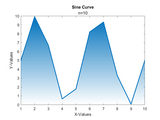Filled Line Chart
Version 1.0.1 (472 ko) par
Alexis Wang
Plots a line chart with a filled gradient using explicit triangulation for optimization.
Citation pour cette source
Alexis Wang (2026). Filled Line Chart (https://github.com/MATLAB-Graphics-and-App-Building/filled-line-chart/releases/tag/1.0.1), GitHub. Extrait(e) le .
Compatibilité avec les versions de MATLAB
Créé avec
R2022a
Compatible avec les versions R2021a à R2022a
Plateformes compatibles
Windows macOS LinuxTags
Découvrir Live Editor
Créez des scripts avec du code, des résultats et du texte formaté dans un même document exécutable.
| Version | Publié le | Notes de version | |
|---|---|---|---|
| 1.0.1 | See release notes for this release on GitHub: https://github.com/MATLAB-Graphics-and-App-Building/filled-line-chart/releases/tag/1.0.1 |
||
| 1.0 |
Pour consulter ou signaler des problèmes liés à ce module complémentaire GitHub, accédez au dépôt GitHub.
Pour consulter ou signaler des problèmes liés à ce module complémentaire GitHub, accédez au dépôt GitHub.


